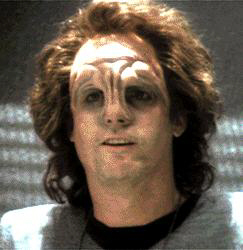
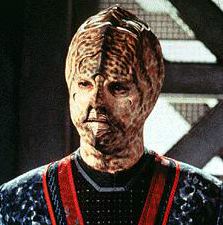
Run your cursor over any picture for more information about the character and talent


Rakhari; (left) Planet: Rakhar, Gamma Quadrant. Humanoid race distinguished by heavy ridges down the nose and full heads of bushy hair. Aware and unafraid of space-farers, they cared little about outside contact through the wormhole and employed a swift and suspect justice system that wielded the death penalty on not only lawbreakers but all of their relatives. DS9 "Vortex" 1-12
Rakosans; (right)
Kellan. First Minister of planet Rakosa V, a highly populated
Class-M planet in the Delta Quadrant. Over two million Rakosans were
threatened in 2372 by Dreadnought. VOY
"Dreadnought" 2-33
Ramatisian;
(left) Planet: Ramatis III. Humanoid inhabitants of a planet off the
beaten Federation path, whose ruling family line is missing its gene
for hearing_much like the Hanovers of Old Earth who suffered from
hemophilia. TNG "Loud As A Whisper" 2-31
2-31
Redjac; Name given to unidentified killer of women on Earth. Also known as Beratis on Rigel IV. TOS "Wolf in the Fold" 2-43
Reegrunion; Planet: name unspecified. Species of illegal arms trader Plix Tixiplik. DS9 "Sanctuary" 2-30
Remmilian;
Planet: Remmil VI. Sentient native species known to the Federation
who spin a crystalline webbing used in building construction, as seen
used in their central museum. 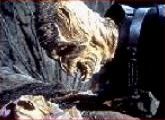 DS9
"Heart Of Stone" 3-60
DS9
"Heart Of Stone" 3-60
Repto-Humanoids; (right) Planet: "Planet Hell" They can stand upright. Although they have a skeletal system of a humanoid, they are cold blooded with a reptilian epidermis. Their young hatch from eggs and thrive on the vapors of the planet. VOY "Parturition" 2-23
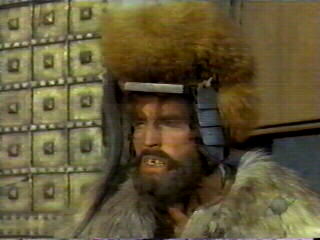 Rigelian;
(left) A humanoid race living on Rigel V.
Their physiology is very similar to Vulcans. They have not achieved
spaceflight but do maintain open relations with the Federation. Since
most of Rigel V is uninhabitable, the Rigellians live deep in
subterranean caves filled with an ancient system of atmospheric
force-fields, oxygen recyclers and heating systems. Their technology
is sufficient to maintain their habitat. Their existence does give
much weight to the "lost colony" theory. Star
Trek. "The Cage" 0-0
Rigelian;
(left) A humanoid race living on Rigel V.
Their physiology is very similar to Vulcans. They have not achieved
spaceflight but do maintain open relations with the Federation. Since
most of Rigel V is uninhabitable, the Rigellians live deep in
subterranean caves filled with an ancient system of atmospheric
force-fields, oxygen recyclers and heating systems. Their technology
is sufficient to maintain their habitat. Their existence does give
much weight to the "lost colony" theory. Star
Trek. "The Cage" 0-0
Rodulans;
Creators of the Basotile, a type of centuries-old metal sculpture of
which Kivas Fajo owned the centuries-old first until his collection
was broken up after his arrest in 2366. TNG
"The Most Toys" 3-70
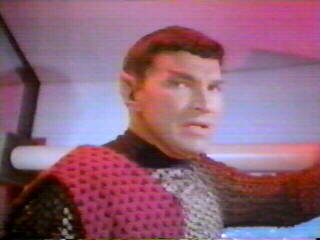 Romulans;
(right)
With the same pointed ears and converging eyebrows, Romulans bear a
very striking resemblance to the Vulcans. For good reason: they are
the descendants of a split from Vulcan society two millennia ago. So
it is assumable that their physiology is nearly identical to the
Vulcans, except in smaller aspects that are the result of
evolutionary adaptation to Romulus conditions. The ears are less
pointed than their Vulcan counterparts, and their features less
severe. Though identical in almost every way to their cousins, the
Romulans lack the rigorous mental disciplines developed by the
followers of Surak. This and the more benign environmental conditions
on Romulus have gradually worn away the physical capabilities of
Romulans in comparison to their ancestors.
Romulans;
(right)
With the same pointed ears and converging eyebrows, Romulans bear a
very striking resemblance to the Vulcans. For good reason: they are
the descendants of a split from Vulcan society two millennia ago. So
it is assumable that their physiology is nearly identical to the
Vulcans, except in smaller aspects that are the result of
evolutionary adaptation to Romulus conditions. The ears are less
pointed than their Vulcan counterparts, and their features less
severe. Though identical in almost every way to their cousins, the
Romulans lack the rigorous mental disciplines developed by the
followers of Surak. This and the more benign environmental conditions
on Romulus have gradually worn away the physical capabilities of
Romulans in comparison to their ancestors.
Society
In Romulan
society, military rank influences social standing. Because Romulans
are militant civilizations who consider defending the Empire and
their own personal honor of foremost importance, military service and
accompanying rank are decisive factors in determining social
eminence. It is a society with a clearly defined caste system. Every
Romulan is accorded a social standing associated with the power and
military rank he commands. The highest ranked Romulan is the
"Fvillha", or chief Praetor, the Speaker of the Praetorate.
He holds immense power, and those under him rank progressively lower
to end with the lowest of the low, prisoners. Prisoners of the
Romulan state are scorned as less than Rihannsu, as Romulans identify
themselves. Without honor, they rank lower than even slaves.
The pillar of the Romulan political organization is the House system. It is a clannish system with hereditary succession to continue the lineage. However, the House is not as narrow in scope as a feudal family, as it encompasses a larger cross-section of society. The servants of a House adopt its name as their own, and though they are not equals to their masters, they are considered part of the House. As with each individual Rihannsu, a House is accorded a social rank and status according to the culminative status of its members and its past service to the Empire. The status of a House can be generalized into two categories, the Greater House and the Lesser House. Both are integral to the social structure of the Romulan Empire. The most important person within a house is the hru'hfirh, or Head of House, and each member of the house is given a station to function in. As adoptions are common in Romulan society, adopted Romulans are accorded the same status and prestige they would have held within their own biological House. However, the adopted may have to bear responsibility to two Houses instead of one. The number of members within a House reflects its social prestige, with more being better. An unique form of revenge in Romulan society is done by kidnapping young children of the rival House and rearing them as their own. Children taken in this way are usually never seen again.
 Respect
and honor form the basis of Romulan society. A lack of deference to
one's rank is to show a lack of "mnhei'sahe", or "the
ruling passion", an appreciation of honor, duty, courtesy and
strength. With Romulans, a successful negotiation must leave all
parties satisfied that they were dealt with honor. Their status,
their "face", must be acknowledged during the proceedings
and remain intact after the encounter. To deny a Romulan appropriate
mnhei'sahe, the offended Romulan may initiate a duel to restore his
honor, or if the disgrace is too great, surrounding parties may
decide to preserve the memory of his honor and kill him before
further damage is done. Mnhei'sahe is not clearly defined in
statutes, but it is a long-standing custom of showing deference and
honor and guides the lives of all true Romulans. Every Romulan knows
by the actions and bearing of another exactly what rank and social
status he has. Subtle observed cues, previous reputation, current
military rank, and past experience all determine the level of respect
accorded to a Romulan.
Respect
and honor form the basis of Romulan society. A lack of deference to
one's rank is to show a lack of "mnhei'sahe", or "the
ruling passion", an appreciation of honor, duty, courtesy and
strength. With Romulans, a successful negotiation must leave all
parties satisfied that they were dealt with honor. Their status,
their "face", must be acknowledged during the proceedings
and remain intact after the encounter. To deny a Romulan appropriate
mnhei'sahe, the offended Romulan may initiate a duel to restore his
honor, or if the disgrace is too great, surrounding parties may
decide to preserve the memory of his honor and kill him before
further damage is done. Mnhei'sahe is not clearly defined in
statutes, but it is a long-standing custom of showing deference and
honor and guides the lives of all true Romulans. Every Romulan knows
by the actions and bearing of another exactly what rank and social
status he has. Subtle observed cues, previous reputation, current
military rank, and past experience all determine the level of respect
accorded to a Romulan.
Though honor
is as integral a part of their society as Klingons, Romulans are not
so physically violent or interested in dying gloriously. They are
however, extremely suspicious of all aliens and will believe only one
of their own. Their words are kept with the knowledge that failure to
do so will mean a fate worse than death: dishonor.
The main force
in Romulan life is honor, but they also acknowledge the reality of
power. The goal of every Romulan is gaining power -- if not for
themselves then for their House and the Empire. The loyalty of
Romulans for the Empire is unquestionable, and the nationalism of
Romulans can always be counted upon in times of conflict. It is their
belief that if mnhei'sahe is with the Empire, glory will remain with
Romulans. TOS "Balance of Terror" 1-14, TAS,
TNG, DS9, MOV,
ENT
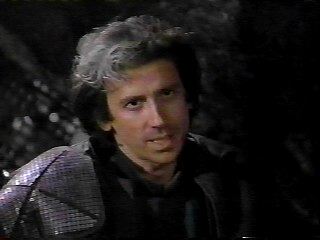 Ramuran;Technologically
advanced civilization from the Delta Quadrant. Their bodies produced
a pheromone that blacks long-term memory engrams in other species, so
that any encounter by a non-Ramuran is forgotten by the non-Rumuran
within a matter of hours. The government did not allow any of its
citizens to leave their society, enforcing this law with
"tracers." VOY
"Unforgettable" 4-98
Ramuran;Technologically
advanced civilization from the Delta Quadrant. Their bodies produced
a pheromone that blacks long-term memory engrams in other species, so
that any encounter by a non-Ramuran is forgotten by the non-Rumuran
within a matter of hours. The government did not allow any of its
citizens to leave their society, enforcing this law with
"tracers." VOY
"Unforgettable" 4-98
Rutian; (left) Humanoids from Rutia IV. Very similar to Terrans and distinguished by their hair. Their males are marked by a distinctive white streak and females usually have red hair. Rutia IV is politically neutral in most aspects but it seeks outside help against an insurgency movement called the Ansata. While their are only around 200 active members on a planet of 4 billion, they are known to have millions of sympathizers and supporters. Rutians have spaceflight technology only sightly behind modern standards. They have significant fleet of scientific and commercial ships with a long history of trading with the Federation. TNG "The High Ground" 3-60